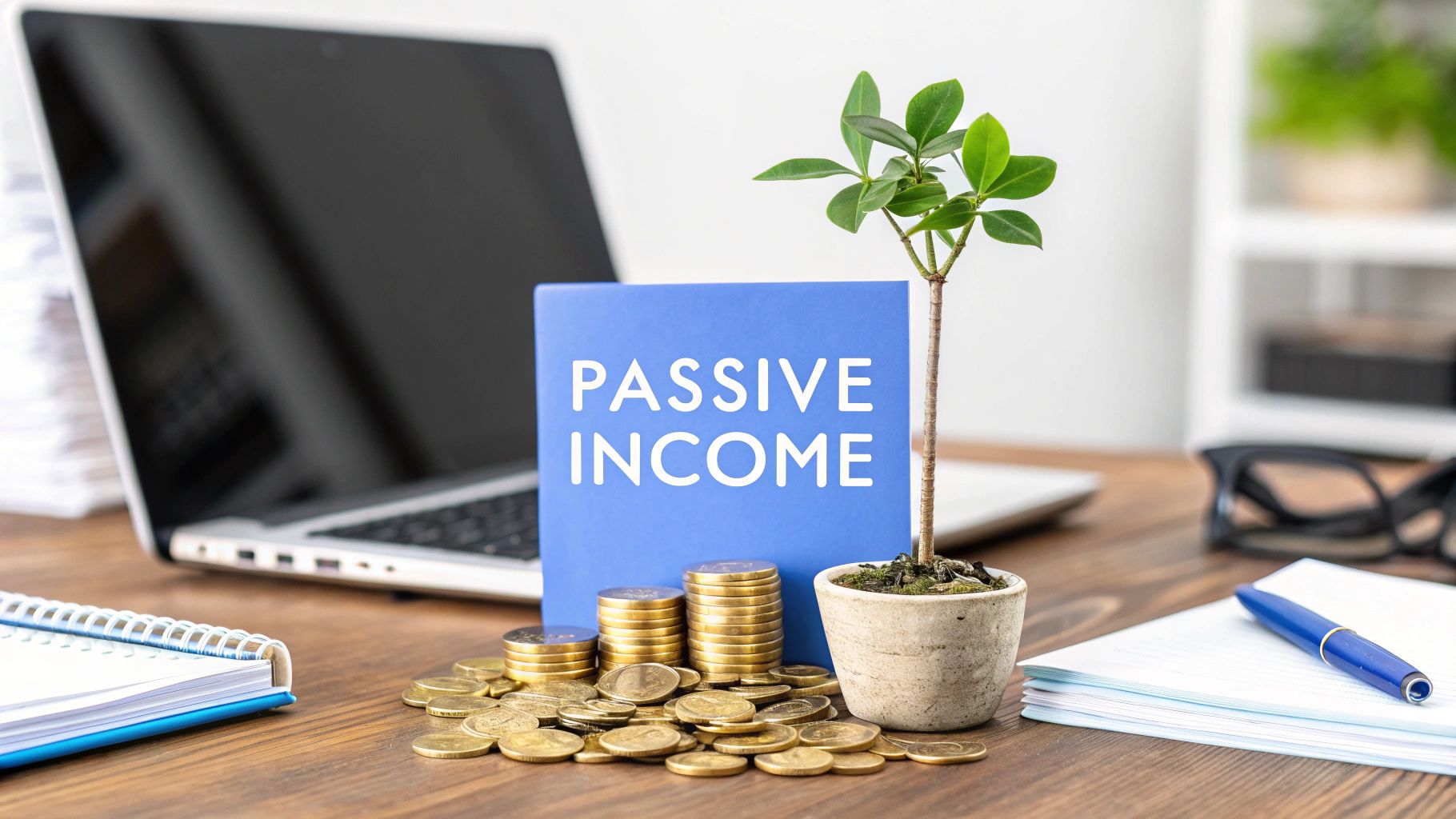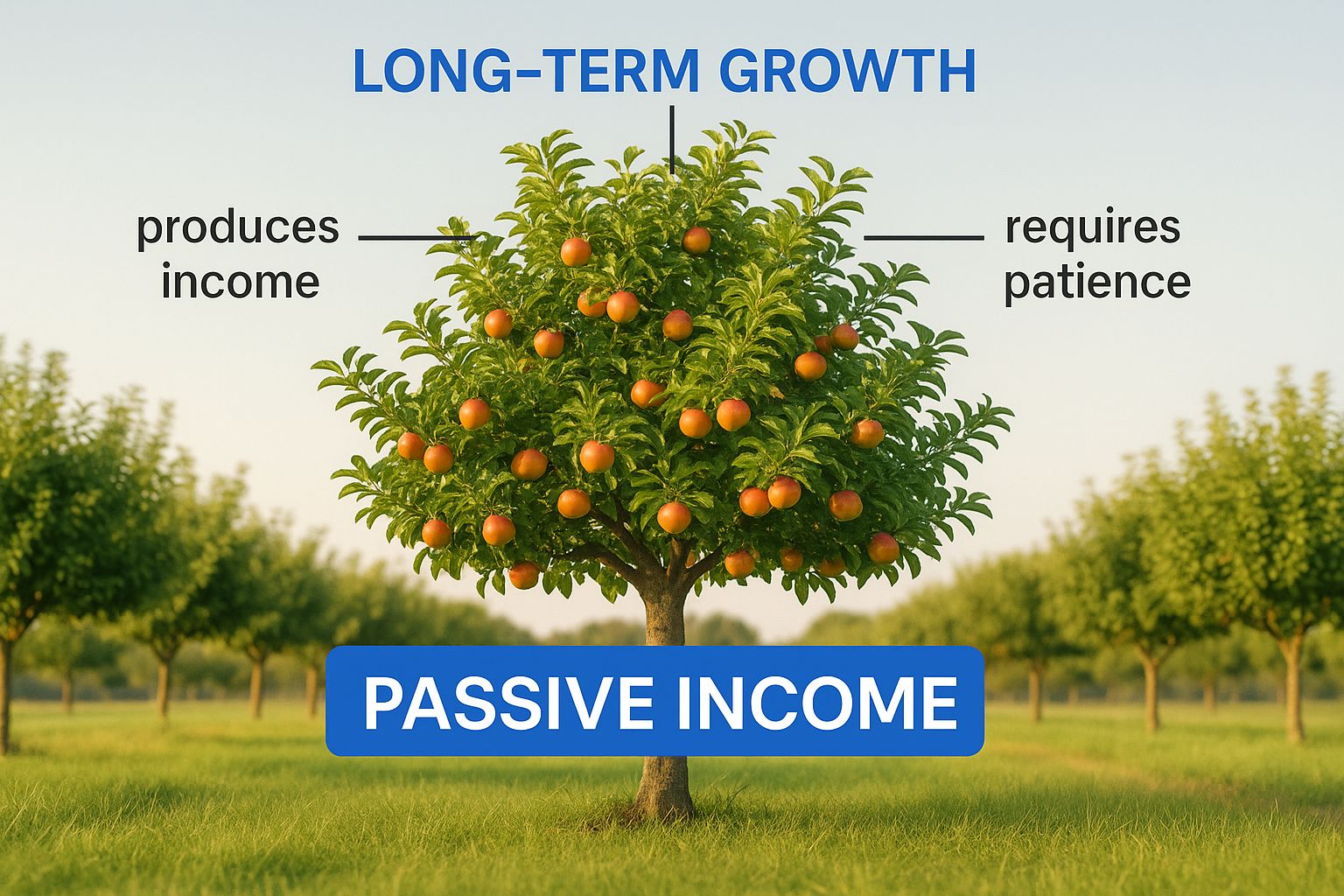Our Marketing Team at PopaDex
What Is Passive Income and How Does It Work

You hear the term passive income thrown around a lot, and it often conjures up images of money magically appearing in your bank account while you nap on a beach. While that’s the dream, it’s not quite the whole story.
So, what are we really talking about? Passive income is about earning money with minimal daily effort, but only after you’ve put in a significant upfront investment of either time or money. It’s not a get-rich-quick scheme; it’s a long-term strategy for building systems that generate cash flow without you needing to constantly be at the wheel.
What Passive Income Really Means
A better way to think about what is passive income is to imagine you’re planting a fruit tree. The initial work is intense. You have to buy the sapling, dig the perfect hole, plant it, and water it religiously. For months, maybe even years, you won’t see a single piece of fruit for all your effort.
But once that tree matures? It starts producing fruit year after year, and all it needs from you is a little maintenance—some pruning here, some watering there. The fruit is your income, and that initial hard work was your investment. The goal is to fundamentally disconnect your time from your earnings. You’re no longer just trading hours for dollars.
This infographic breaks down the concept beautifully, showing it as a growth strategy, not an overnight win.

Just like a healthy tree, a solid passive income stream is an asset. It’s something you build or acquire that grows and produces value over time, freeing you up to do other things.
The Different Shades of Passivity
It’s also crucial to understand that “passive” isn’t an on-or-off switch. It exists on a spectrum. The effort required can vary wildly, creating different shades of passivity.
- Mostly Hands-Off: Think dividend stocks or a high-yield savings account. Once you’ve put the money in, there’s very little to do besides checking in on your portfolio every so often.
- Requires Some Maintenance: Rental properties are a classic example. Sure, the rent check comes in every month, but you still have to deal with leaky faucets, find new tenants, or pay a property manager to handle it for you.
- Upfront Creation, Later Automation: This is the world of digital products. You might spend hundreds of hours writing an e-book or filming an online course. All the work is front-loaded, but once it’s done, the sales process can be almost completely automated.
The core idea isn’t a total absence of work. It’s about creating an asset that works for you. It’s a strategic shift from active labor to asset ownership, and it’s a move more and more people are making.
The pursuit of passive income has exploded since the mid-2010s, largely because new technologies and economic shifts have made it more accessible than ever. In fact, as of 2025, around 20% of American households report having some form of passive income, a major jump from decades past. You can dig into more small business trends and see how this is evolving over on llcattorney.com.
Getting this realistic foundation right is the first step. From here, you can start building real, lasting wealth.
Active Income vs Passive Income Compared

To really get why passive income is such a big deal, it helps to put it side-by-side with its more familiar cousin: active income. Most of us know the active model inside and out—it’s the bedrock of the traditional workforce and how the majority of people earn a living.
Simply put, active income is the money you get for directly trading your time and effort. Think of your 9-to-5 job, a freelance gig, or even driving for a rideshare app. The formula is straightforward: if you work, you get paid. If you stop working—for a vacation, an illness, or retirement—the money stops, too. Your earnings are locked to the hours you put in.
Passive income, on the other hand, breaks that direct link. It’s money that flows from assets you’ve built, bought, or invested in. These assets do the heavy lifting for you, generating cash with minimal day-to-day effort on your part. While it often demands a serious upfront investment of time or money, the entire point is to build a system that keeps paying you long after that initial work is done. This is the core reason understanding what is passive income is so critical for anyone serious about their long-term financial health.
Active Income Versus Passive Income At a Glance
Let’s make this crystal clear with an example. Imagine a talented chef. Her active income is the salary she earns working in a restaurant, cooking meals for customers every night. Her paycheck depends entirely on her showing up for every shift.
Now, let’s say she writes a cookbook full of her signature recipes. The months she pours into writing, testing, and getting it published are her upfront investment. But once it hits the shelves, every single copy sold earns her a royalty payment. This is her passive income. She could be asleep, cooking at the restaurant, or on a beach somewhere, and still earn money from a book sold in another country. The cookbook—the asset she created—is now working for her.
This table neatly summarizes the core differences between these two powerful ways of earning.
| Attribute | Active Income | Passive Income |
|---|---|---|
| Time Commitment | Ongoing; directly tied to earnings. | Primarily upfront; minimal ongoing maintenance. |
| Income Source | Salary, wages, freelance fees. | Dividends, royalties, rent, interest. |
| Scalability | Limited by the number of hours you can work. | Highly scalable; not limited by your time. |
| Long-Term Potential | Capped by your hourly rate or salary. | Potential for exponential growth and compounding. |
The crucial shift is from working for your money to having your assets work for you. Active income pays the bills today, while passive income builds wealth for tomorrow.
Ultimately, both income types are essential for a robust financial life. Your day job provides the stability and immediate cash flow you need right now. You can then channel that money into building or buying the assets that will generate passive income down the road. It’s this one-two punch that secures your present while you strategically invest in your future freedom.
Popular Types of Passive Income Streams

Alright, you get the basic idea behind passive income. Now for the fun part: figuring out which streams are right for you. The world of passive income is massive, with opportunities for every budget, skill set, and appetite for risk. It’s less of a rigid path and more like a menu of financial options you can mix and match to build the future you want.
To get a handle on it all, we can break down the most common streams into a few major categories. Each one has its own flavor—some require more cash upfront, others demand your creative energy, and a few are all about business savvy. The key is finding your fit.
Investment-Based Income Streams
This is the classic way to earn passively: you put your money to work, and it does the heavy lifting for you. The whole point is to buy assets that kick off a steady return with as little hands-on effort as possible.
- Dividend Stocks: When you own shares in stable, profitable companies, they often share a slice of their earnings with you. These payouts, called dividends, can create a regular cash flow while the value of your stock hopefully climbs over time.
- Real Estate: A true cornerstone of wealth-building, real estate offers a few routes. You can buy rental properties for monthly income or look into investment homes for long-term appreciation. Don’t want to be a landlord? Real Estate Investment Trusts (REITs) let you own a piece of a large portfolio of properties without the hassle.
- Peer-to-Peer Lending: Online platforms now let you become the bank. You can lend money directly to individuals or small businesses and earn interest on your loan.
Thanks to a flood of new investing apps, getting started is easier than ever. You can now jump into real estate with as little as $10 and potentially earn $50–$500 per month, depending on what you’re invested in. This shift has opened up opportunities that were simply out of reach for most people just a decade ago.
Creator-Based Income Streams
If you’ve got a skill, a passion, or a deep well of knowledge, you can turn it into a digital asset that sells again and again. This approach takes a big investment of time and creativity on the front end, but the payoff can be huge.
The real magic here is that you build it once, and it can sell forever. Think about it: a single e-book or online course can bring in money for years with just a few small tweaks.
The core principle is simple: Create an asset once, and get paid for it repeatedly. This model decouples your time from your earnings in a powerful way, offering true scalability.
A few popular examples include:
- Digital Products: Selling things like e-books, online courses, or handy digital templates.
- Royalties: Earning a percentage from your creative work, whether it’s music, photography, or a published book.
- YouTube Ad Revenue: If you’re comfortable on camera, creating videos that earn money from ads can become a serious income stream.
Business-Based Income Streams
The final category is all about building a system—a business that can pretty much run itself. This definitely requires more strategic thinking and setup than the other types, but it also has the highest potential for big returns. If you’re new to this, exploring some different passive income ideas for beginners is a great way to see what’s possible.
These streams are built on automation and solid systems that generate profit without you needing to be there 24/7.
- Affiliate Marketing: You promote products for other companies and get a commission for every sale that comes from your unique link. It’s a go-to for bloggers and content creators.
- E-commerce Automation: You can set up a dropshipping store or use a service like Fulfillment by Amazon (FBA). This lets you sell physical products without ever touching inventory or dealing with shipping.
- Software or Apps: Building a simple app or a software-as-a-service (SaaS) tool that solves a real problem can create a steady stream of recurring subscription payments.
Myths and Risks You Need to Understand
The dream of earning money while you sleep is incredibly appealing, but it’s important to walk into this with your eyes wide open. The internet is flooded with stories that paint a picture of easy, automated wealth, conveniently leaving out the real-world challenges and risks involved. Understanding what is passive income also means knowing what it isn’t—it’s certainly not a magic button for instant riches.
Let’s get one thing straight: if someone promises you zero-effort income, they’re probably selling you something. The truth is that every single passive income stream comes with its own set of risks and requires a hefty upfront investment of either your time, your money, or a combination of both.
The Myth of “Set It and Forget It”
One of the biggest misconceptions out there is the idea that you can just “set it and forget it.” While it’s true that some income streams need less day-to-day meddling than others, absolutely none of them are truly hands-off forever.
A passive income stream is like a garden. You can’t just plant the seeds and walk away expecting a bountiful harvest. It requires ongoing attention—weeding, watering, and protecting it from pests—to keep it healthy and productive.
Think about it. A portfolio of dividend stocks needs to be rebalanced from time to time. A rental property will inevitably need repairs. An online course will need updates to stay relevant. Forgetting about your assets is the quickest way to watch them wither and stop producing income.
Common Risks to Consider
Diving into the world of passive income means being ready for a few bumps in the road. If you don’t acknowledge the risks from the start, you’re setting yourself up for financial disappointment or even serious losses.
Here are a few of the big challenges you need to keep on your radar:
- Market Volatility: Income based on investments, like stock dividends or REITs, is directly tied to the whims of the market. An economic downturn can shrink your earnings or wipe them out completely for a while. You have to know your own risk tolerance before you jump in.
- Significant Upfront “Sweat Equity”: For anything you create yourself, the initial grind is massive. Writing a book, building a digital product, or launching a successful affiliate blog can soak up hundreds of hours with no guarantee of a payoff. Some projects just never take off.
- Income Stream Decay: What works like a charm today might be obsolete tomorrow. An affiliate program could shut down, a rental property could sit empty between tenants, or a digital product that was once a bestseller could fall out of fashion. This is why diversification is your best friend.
- Miscalculating Your Returns: It’s easy to get carried away by the potential earnings, but you have to stay grounded in reality. To get a clearer picture of your potential gains, it’s a good idea to learn how to calculate your rate of return on any investment you make.
By facing these challenges head-on, you stop being a dreamer and start acting like a strategist. This shift in mindset allows you to build a resilient, diversified portfolio of income streams, manage your expectations, and make smarter moves on your journey to financial freedom.
Your Framework for Building Passive Income
Turning the dream of passive income into reality isn’t about stumbling upon a get-rich-quick secret. It’s about building a solid plan. A clear, repeatable framework helps you avoid chasing every shiny new opportunity and instead lets you build sustainable wealth, one smart decision at a time.
The first step? You have to know where you’re going. Vague goals like “make more money” are impossible to act on. Get specific. Is your aim to generate an extra $500 per month to cover your car payment? Or are you playing the long game, looking to build a $1 million portfolio in 20 years? Clear, measurable targets are the bedrock of any successful financial strategy.
Take Stock of Your Resources
Once you have a goal, it’s time for an honest look at what you’re working with. Your resources pretty much boil down to three things:
- Time: How many hours a week can you realistically put in? Creating a digital course might demand hundreds of hours upfront.
- Money: How much capital can you actually invest? Some streams, like dividend stocks, need cash to get started. Others, like affiliate blogging, lean more heavily on your time.
- Skills: What are you already good at? Your expertise in a niche could be the foundation for an e-book, a course, or a blog that pulls in affiliate revenue.
This simple self-inventory will instantly filter your options, pointing you toward passive income streams that are a natural fit for you right now.
Your ideal starting point lies at the intersection of your goals, your available resources, and your genuine interests. Choosing something you’re passionate about is the ultimate motivation to push through the initial hard work.
Start Small and Reinvest Everything
You don’t need a massive pile of cash to get started. The real key is to pick one manageable idea and just focus on getting it to make its first dollar. Whether you start by writing a single affiliate blog post or investing $100 into a dividend ETF, the most important thing is simply to begin. Our guide on how to start investing money can help you take those crucial first steps.
Once your asset starts to generate cash, resist the temptation to spend it. The magic happens when you reinvest every single penny back into the system. That $50 in monthly dividends can buy more shares, which then produce even more dividends. This cycle is how small beginnings snowball into serious wealth over time. For a deeper dive on setting up systems that minimize your active work, check out these strategies for building a business that runs itself.
This disciplined approach is becoming even more critical as investors search for stability. With all the global economic uncertainty, there’s a clear shift toward assets that provide reliable cash flow, like dividend-paying stocks. While broad market indices offer modest yields, certain sectors can deliver much higher returns, making them a very attractive option for anyone serious about building passive income.
Answering Your Top Passive Income Questions
As you start digging into the idea of passive income, a bunch of practical questions are bound to surface. Moving from “what if” to “how-to” means facing the real-world details. Let’s tackle some of the most common ones to give you a solid footing before you take the next step.
These aren’t just random curiosities; they’re the biggest hurdles most people hit when starting out. Getting clear on them now will help you build a much smarter and more resilient financial plan from day one.
How Much Money Do I Need to Start?
This is, without a doubt, the question I hear most often. And the answer is pretty freeing: you can start with any amount. There’s a stubborn myth that passive income is a rich person’s game, but that’s just not true anymore. The capital you need depends entirely on the path you choose.
Got more time than money? You could launch an affiliate blog or create a digital course with almost zero upfront cash. On the flip side, if you have a little money to put to work, you could open an investment account and buy into a dividend-paying ETF for as little as $10.
- Low-Capital Start: Launching a niche blog and using affiliate marketing. Your main investment here is your time creating valuable content.
- Small-Capital Start: Investing small, regular amounts into a high-yield savings account or a low-cost index fund.
- High-Capital Start: Buying a rental property or making a significant investment in a peer-to-peer lending platform.
The goal isn’t to start with a massive nest egg. The goal is simply to start.
Is Passive Income Really Passive?
Okay, let’s be honest—the word “passive” is a bit of a misnomer. A more accurate way to think about it might be “leveraged income,” because every single stream requires work. The crucial difference is when you do that work. Instead of trading hours for dollars every single day, you put in a significant amount of effort or capital upfront to build an asset.
The “passive” part isn’t about the absence of work; it’s about decoupling your time from your earnings. You build the system once, and it keeps generating value with minimal ongoing effort.
Think about writing an e-book. It might take 200 hours of focused effort before it makes a single cent. But once it’s published, it can sell copies for years with just a few minor updates. The income becomes passive after the intense, active creation phase is done. You’ll still need to do some maintenance—like rebalancing a portfolio or refreshing an online course—but you’re no longer trading time for a paycheck.
What Are the Tax Implications?
Taxes are a critical, and often overlooked, piece of the puzzle. The rules can get complicated and change quite a bit depending on where you live and the type of income you’re earning. In short, yes, this income is almost always taxable, but it’s often taxed at different rates than the salary from your 9-to-5.
For example, in the United States, income from long-term capital gains and qualified dividends is generally taxed at a much lower rate than your regular earned income. Rental income has its own set of rules, letting you deduct expenses like mortgage interest, property taxes, and depreciation. Because the details matter so much, one of the smartest investments you can make is consulting with a tax professional. They can help you structure your income streams to be as tax-efficient as possible, making sure you keep more of what you earn.
Ready to see all your income streams—active and passive—in one simple dashboard? PopaDex gives you a clear, real-time view of your entire financial world, helping you track your net worth and make smarter decisions as you build wealth. Take control of your financial future by visiting https://popadex.com to get started for free.